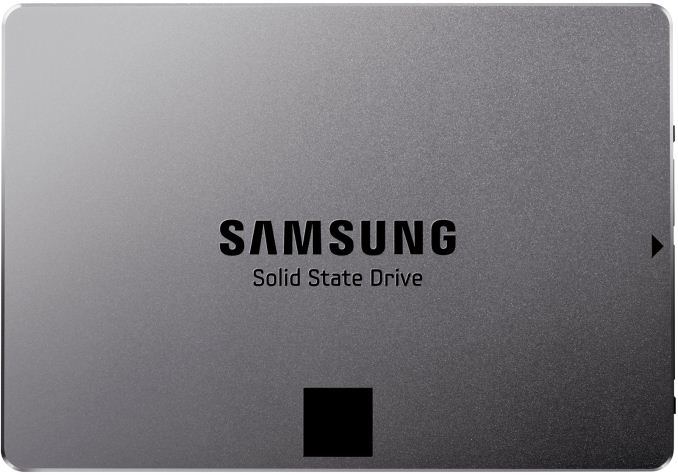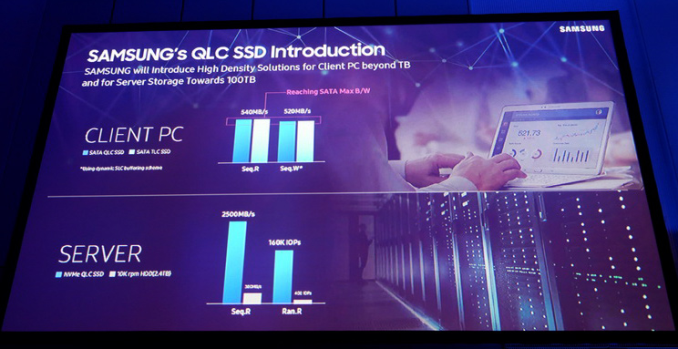Samsung Discloses First Details About QLC-Based Client & Server SSDs
by Anton Shilov on July 25, 2018 12:00 PM EST
It is not a secret that Samsung deliberately avoided QLC NAND with its 64-layer V-NAND flash, in the process citing various reasons. With its 96-layer V-NAND however, the company is changing its approach and is going to offer QLC-based SSDs for client and server computers. At the Samsung SSD Forum in Japan the company disclosed the first details about the upcoming drives.
The key advantage of 3D QLC NAND over 3D TLC is of course a 33% higher storage density and therefore a lower per-bit storage cost (assuming a similar yield). Therefore, the first drives to adopt Samsung’s 3D QLC V-NAND will be high-capacity SSDs for those customers who need to store a lot of data and may not be that interested in the maximum performance.
Samsung has been openly working on ultra-high-capacity SAS/U.2 SSDs based on QLC V-NAND memory for well over a year now. These drives will be used for WORM (write once, read many) applications not optimized for fast writes, but clearly outperforming HDD-based arrays. Samsung expects its first QLC-powered NVMe drives to offer up to 2500 MB/s sequential read speed as well as up to 160K random read IOPS, significantly outperforming high-end 10K RPM HDDs. Evidently, high-capacity QLC-based SSDs are supposed to substitute multiple 10K RPM hard drives working in a RAID array, so comparing performance of a single SSD to a 2.4 TB HDD may not be too representative, especially when power consumption is taken into account.
Another lineup of Samsung’s products to use 3D QLC V-NAND will be client SSDs featuring capacities higher than 1 TB. These drives will use a SATA interface and will offer sequential read and write performance of around 520 MB/s (when SLC write caching is enabled), according to details that Samsung disclosed at its SSD Forum. Samsung does not disclose when such drives are set to become available, but the company says that Terabyte-class client SSDs will become mainstream in 2020 because of QLC V-NAND.
In the meantime, Samsung does not expect QLC V-NAND to replace TLC V-NAND as the mainstream type of flash memory any time soon. QLC NAND requires more expensive controllers with considerably higher processing capabilities to guarantee a proper endurance. Therefore, the low-cost per-bit advantages of memory may not be that obvious on client SSDs.
Related Reading:
- Samsung Begins Mass Production Of 96L 3D NAND
- Western Digital Begins to Sample QLC BiCS4: 1.33 Tbit 96-Layer 3D NAND
- Intel Teases Upcoming QLC SSD For Datacenters
- We Found a Prototype 4 TB Intel QLC SSD
- Intel QLC NAND Updates: Up to 20TB In 2.5-inch SSD
- Intel And Micron Launch First QLC NAND: Micron 5210 ION Enterprise SATA SSD
- Toshiba's 768Gb 3D QLC NAND Flash Memory: Matching TLC at 1000 P/E Cycles?
Source: PC Watch











16 Comments
View All Comments
PeachNCream - Friday, July 27, 2018 - link
Yes, twice with 120GB Patriot Torch drives.Alexvrb - Thursday, July 26, 2018 - link
Yay for zero empirical data supporting your claims! Yay for you can still buy a TLC drive if you need more speed and less capacity!porcupineLTD - Saturday, July 28, 2018 - link
Exactly the 960 evo from samsung which uses TLC already has under 500 p/e cycles (100TB TBW written for 250 GB drive) so the empirical evidence suggests that QLC will be under 500.CheapSushi - Sunday, July 29, 2018 - link
Actually the target from all of the players is 1,000 P/E cycles, the same as planar TLC.AbRASiON - Thursday, July 26, 2018 - link
Year after year after year, I wait for something to put in my NAS that isn't hot, spinning, noisy. Alas, nothing has come.I first wanted this in late 2014. News articles at the time and 2015 made me think, 2018 it might be viable.
Now, 3.5 years later. I sit, thinking "maybe by 2021, my NAS will finally be rid of hot, noisy things?"
Who knows, patience is a virtue I guess. It's been a long wait.
oRAirwolf - Friday, July 27, 2018 - link
With Western Digital EasyStore 8TB external drives for $150 that can be shucked for the WD Red NAS inside, I can deal with a little heat and nose. QLC isn't going to hit that price point for a loooooong time. I have eight of those drives in a Dell T320 chassis running FreeNAS with a 10 gigabit link to my desktop and I get over 600 megabytes per second read and write with compression enabled in RAIDZ1. I think that is about as good as you're going to get for the time being. If you need faster storage, you could get an Icydock 4x2.5" or 8x2.5" drive bay adapter that goes into a 5.25 inch bay and have a separate pool for fast storage.